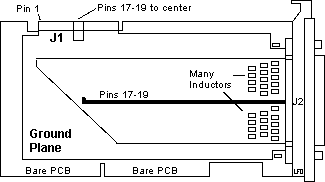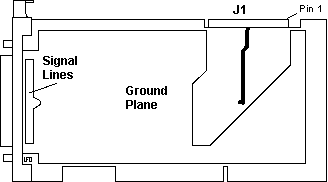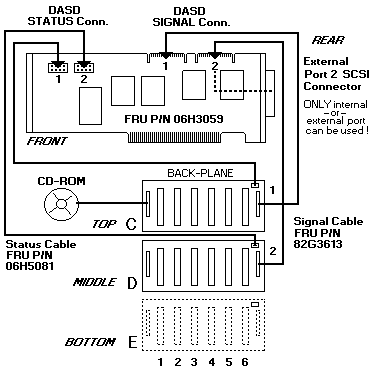|
@8F82.ADF IBM SCSI-2 Fast/Wide Streaming-RAID Adapter/A
194-170 IBM SCSI-2 F/W Streaming-RAID Adapter/A
4227110.EXE FWSR Option Disk #1, v2.31 (zipped image)
Contains Disk Configuration Utility for "Cheetah" and "Passplay"
4227111.EXE FWSR Option Disk #2, v2.31 (zipped image)
Readme for FWSR Option Disks
10L9849.EXE RAID Supplemental Diskette v2.0 (OS/2 command-line interface)
Readme for Supplemental Diskette
SCSI-2 Fast/Wide Streaming RAID Adapter/A
Side Card
Function of NVSRAM
Cable Parts
HD LED Does Not Work
HD LED Hack
Cyrix/Non-SOD Type 1 Incompatibility?
Cache Size
Accessing the RAID Configuration
Configuration Utility
FWSR BIOS Flash Disk
Cheetah in a 85 / 95 /95A
Cheetah in a Server 500
Channel and RAID adapter configurations (takes you to 8641 page)
Getting CD-ROM to WORK On Server 500
Linux on FWSR?
Logical Drive Size Limits under NT
Specifications
ADF Sections
SCSI-2 F/W Streaming RAID Adapter/A "Cheetah"
FRU P/N 06H3059, P/N 55075-D, FCC ID ANO70G9263
![Front [P]](/other/img/photo.gif)
![Back [P]](/other/img/photo.gif)

D1 Motorola M 420 B34 (CH1)
D2 Motorola M 420 B34 (CH2)
F1 PTC for CH1 150 JH9E
F2 PTC for CH2 / Ext 150 JH9E
J1 CH1 68-pin card edge connector
J2 CH2 68-pin card edge connector
J3 4-pin female header, unknown
J4 CH1 DASD Status connector
J5 CH2/Ext. DASD Status connector
J6 Status LEDs header
J7,8 pads for 2-pin jumper, shunted
J9 External 68-pin MDX port
J10 pads for 3-pin jumper, bottom two shunt.
J11 pads for 2-pin reset header, open
TP1 i960 -FAIL test point
TP2,3 Ground test point
|
U4 DDU8F -5006 Delay line?
U5-7 UC5603DP Active SCSI Terminator
U8,13 Pads for additional memory
U9,22,23,24,28 IDT 74FCT162543CTPA
U10-12 UC5603DP Active SCSI Terminator
U14 189108 4L08F1449 gate array?
U15 NCR 53C720 (CH1)
U16 NCR 53C720 (CH2)
U17,21 43G6625 or 43G6205? memory
U18 Intel A80960CA25
U19 34G1521 "Miami" MCA iface
U25 Dallas DS1233 EconoReset
U30 Flash ROM
U32 Dallas DS1225Y-200 8Kx8 NVRAM
(alt)
Y1 50.000 MHz osc (i960, div by 2)
Y2 40.000 MHz osc (bus/DMA)
|
Note: Channel 2 is connected to J2 (edgecard) and
J9 (external 68 MDX). Do not connect devices to both ports. One -OR- the other,
not both. It probably won't smoke things, but this isn't a SCSI-1 narrow 5MB/s
device, either.
U14 189108 4L08F1449 gate array? Probably
replaces most of the discrete glue logic from Passplay.
U15,16 NCR or Symbios Logic 53C720;
Datasheet,
Programming Guide
U18
Intel A80960CA25,
Intel A80960CF (substitute);
i960 Performance Brief
Jumper J6 is a 6-pin header that
provides a connection for three status LEDs. Pin 1 is to the left end of the
board. In each case the odd-numbered pin is the +5V source. An external series
resistor is not required for the LEDs.
| Pin |
Name |
Meaning |
| 1-2 |
SCSI Activity |
One or two SCSI channels xmitting or recving data. |
| 3-4 |
Write Pending |
DAC960 xmitting/recving data to/from host system. |
| 5-6 |
|
DAC960 cache has data more current than on HDs. |
DAC960 LED Error Reporting
When any DAC960 is powered up, the i960 CPU performs a sequence hardware
tests. Failure(s) is indicated by flashing an error-code on the Write Pending
LED. An appropriate BIOS error message is also on the system. The memory parity
error (irrecoverable), during card operation, is also indicated by the same
LED.
| DAC960 Write Pending LED post on DAC960 |
| 1 or 2 Channel |
Header J2 (non-populated) |
| 3 Channel |
Pin 5-6 of 6 pin header J6 |
| 5 Channel |
Pin 5-6 of 6 pin header J6 |
The LED blinks will always be repeated at regular intervals.
| LED Pattern |
Error Indicated |
| Constant ON/OFF at 50% duty cycle |
Parity error on DRAM. FATAL Error. Check DRAM. |
| 2 blinks |
DRAM error. FATAL Error.
Check DRAM. DRAM support logic failure is
likely. |
| 3 blinks |
BMIC I/F failure. FATAL Error. |
| 4 blinks |
Firmware checksum error. Try
loading Firmware using DAC960FL utility. |
| LED stays on at power-up |
Controller dead. |
i960CA is pin AND function compatible
with the i960CF. The i960CF adds a 4KB cache (or something). People have
swapped out the CA with a CF for @ 10% increase in performance.
Note: The i960Hx seems cool, but lacks a DMA
controller, some pins are used for different purposes, and though 5v tolerant,
needs current limiting on the Vcc line. No Holy Joy here, move along.
Cheetah Side Card FRU P/N 06H3060
Side Card - Front

Wow. Simple but elegant. Area marked "Ground Plane" surrounds the central
area of the side card. The individual signal lines are on this side, and each
goes straight over to an inductor before continuing on to the SCSI port,
J2.
J1 on this side is unusual compared to other MCA cards. All pins on this
side are connected to ground, with the exception being 17, 18, and 19. These
three pins are brought out separate to the center of the board, where they cut
over to the SCSI port.
The edge that fits into the MCA slot is bare PCB, no resist, no nothing. No
MCA bus signals or power is drawn by this side card.
Side Card - Rear

This side resembles the component side. The signal lines come off J1 (a
normal looking edgecard) and go down to their through holes, where they cross
over to the front side. Then they are routed to the SCSI port.
Signal Lines is an area uncovered by the ground plane where the signal lines
connect to the SCSI port header. The ground pins are inside (and connect to)
the ground plane.
Channels
The Cheetah has two channels. Each channel is controlled by an NCR53C720.
The header J1 is Channel 1. It usually is attached to an internal array, but
with the addition of a side card, it can control an external array. The second
channel uses J2 OR the external port, J9. This is still one channel, so one can
use either the internal port, OR the external port. Do NOT try to use both J2
and J9 at once.
Notes:
NVSRAM is a Benchmarq 28 pin 8Kx8 bq4010YMA-200
(datasheet)
Another equivalent is a Dallas DS1225Y-200
(datasheet)
NVSRAM Functions
Each NV SRAM has a self-contained lithium energy source and control
circuitry which constantly monitors Vcc for an out-of-tolerance condition. When
such a condition occurs, the lithium energy source is automatically switched on
and write protection is unconditionally enabled to prevent data corruption.
Cable Parts
The mini C68 for the Channel edgecard
connectors is the Molex 71660i,
part# 15-92-3068, called a half pitch Centronics, or a
VESA Media Connector. Suprise! AMP makes a similar part
(mini-C68) AMP Part 1-557089-2
Any cable with a .025 pitch, 28 to 30 AWG will work with
either connector.
A Better Cable Hack?
Allen Brandt wrote:
> A small, shotty attempt to get something uploaded
concerning the PS/2. HERE
My Take on it:
I am starting to have neurons fire. Actually, Allen provided the
push. Al went and slit the conductors for better flexibility (in pairs).
Could you slit the flat cable up towards the controller and get the very
flexible cable bundle of the IBM original? The black sheathing is available
from Jameco for about $1 a foot. Well worth it, IMHO. (Start the slit with an
X-Acto and use the reverse of the blade to finish parting the
conductors???)
The sheathing is Techflex Cable Sleave,
looks to be the 3/8" size. Sold in a 25' spool. Part #162157,
Product # CCPT2X per spool $14.95 Techflex is HERE
What kind of signal degradation might occur? Each signal
pair hopefully cancels it's noise out.
If the Brandt maneuver can be done from the top drive connector to the
adapter, it might be a close match to the real thing
HD LED Doesn't Work
From Peter (or Tim?)
The fixed disk light is non-functional with both the Server 95 A
"Passplay" and Streaming-RAID "Cheetah" MCA RAID adapter. I suspect this
is also the case with other OEM'ed Mylex RAID adapters.
LED For Cheetah
BUT if you take an LED off of J6, pin 1 and 2, it will light when
the drives are accessed. Just run a lead up to between the LED blocks in the
display panel. Watch the polarity. If the LED doesn't light, switch the header
around. You do not need a resistor for this.
I tried this, but the LED didn't have enough umph. Pretty dim through the
LED Panel. Maybe some sort of a drive circuit? Just had a thought- twist
the existing HD LED out of the Op Panel and put the LED that is connected to J6
in there...
Possible Cyrix-Cheetah Incompatibility?
Tim Clarke
Hi gang,
Just thought that I'd better warn you. After checking out the
Cyrix 5x86 at 4x clocking (in Type-1 non-SOD w/cache) my PassPlay RAID adapter
seems to have been "duffed up". I only get a part of the BIOS v1.05
initialization / installation message and the machine hangs (with *any* CPU) at
CP:96. Looks as though the Flash ROM has been partially overwritten (just a
guess).
Cache Size
Go HERE for more information.
Access the RAID Configuration
Both the FWR (Passplay) and FWSR (Cheetah) are only configurable
through the RAID Utilities disk. You CANNOT see the SCSI Disks under "Set and
View SCSI Devices" like normal SCSI drives. Boot with FWSR Option Disk, #1 ver. 2.31 in order to view or
configure the array.
Both adapters use the same Utilities disk of the later IBM F/W Streaming
RAID Adapter /A (Codename "Cheetah" - with external port) since both are based
on Intel i960 / Mylex / NCR technology. There was a single-disk version 2.22,
which should be unique for all /A RAID adapters of that kind, but not the PCI
versions. The RAIDADM (manager) should work on both /A adapters.
Configuration Utility
version 2.31 consists out of two disks:
FWSR Option Disk, #1 ver. 2.31
FWSR Option Disk, #2 ver. 2.31
Readme for FWSR Option Disks
Not sure if this fits:
RAID Supplemental Diskette Version 2.0
(Readme.txt) RAIDSEND is a
utility that provides an OS/2 ONLY command-line
interface for performing various tasks on a IBM F/W
Streaming RAID Adapter/A, the IBM SCSI-2 F/W PCI-Bus
RAID Adapter, and the Mylex PL adapter for the IBM PC
Server 704.
Fast/Wide Streaming RAID Flash BIOS for "Cheetah"
Caution! The Passplay and the Cheetah differ in
the microcode, which *may not* be interchanged. The Passplay (FWR) adapter uses
a microcode-level 1.6x through 1.99, the Cheetah (FWSR) uses 2.xx levels. If
you flash the one adapter with the code from the other you end up in
non-functional adapters.
FWSR Flash BIOS 2.21 For RAID controller WITH external port!
(zipped image)
FWSR Flash BIOS Readme
Cheetah in a Model 95
The RAID bay for the 85/95/95A does not have a place for the status cable to
attach. The RAID bay has a 68 pin edgecard at the back where the Molex style
SCSI connector attaches to. The 95 RAID bays automatically terminate the SCSI
drives inside. Do NOT enable termination on the individual drives!
I installed a CD-ROM in Bay 7. I used a 68 to 50 pin adapter from the RAID
cable connector. I have installed both NT Workstation 4 and OS/2 on it. Both
were able to detect and use the CD-ROM during setup. FWIW, I had only one bay
with three drives in it.
Cheetah in a Server 500

Setting the CD-ROM ID in a Server 500
I think I saw a patch
somewhere to "fix" a CD on the FWSR under NT.
From Rich Nagle:
Following repeated failures of NT 4 Server setup to recognize the
CD-ROM connected to the passthrough connector on the top backplane, I noticed
that the CD-ROM was showing up as one SCSI ID# higher than it was when I
checked it under the RAID Utility View Configuration.
After checking the SCSI ID jumper on the backplane (set to LO for IDs 0 thru
5 on the backplane), a sudden flash of inspiration occurred - I set the CD-ROM
to ID 5, went back under the RAID Utilities, and the CD-ROM was now ID6. I then
deleted, then recreated the array. Now when I ran NT Setup the CD-ROM was
recognized automatically.
Linux on FWSR?
From Peter (edited):
> Is anyone running linux on one of these machines?
Not on machines with the IBM RAID controller with the old 2.43 firmware. No
Linux driver available.
The IBM Fast/Wide Streaming RAID Adapter PCI as used in the Server 320/520
MCA-PCI versions is derived from the Mylex DAC960PL - it only has 128K Flash
ROM (one 28F010 chip) but a second open socket. Firmware 3.x requires 256K
Flash. I'd tried to plug in a second 28F010 ... but I think the old software
contained in that chip confused the adapter a bit ... it behaved a little
"strange" (long boot time etc.)
What I do not have is an EPROMmer that is capable to write the Flash ROMs of
the 28Fxxxx series or I could a) write a spare 2.4x Flash (to keep for the
"worst case") and b) clear the 28F010 ROMs I pulled from some old boards. Else
I would stuff in a blank ROM in the second socket, have the old 2.xx in the
first and run a firmware update 3.x from the DAC960PL on that adapter.
The machines with the older RAID adapters ("Passplay" and "Cheetah") based
on MCA technology are out of the discussion anyway. They are based on the
DAC960M technology but an older implementation of that concept. They use some
of the chips of the -M and early -Px adapters (PL / PD) and they are developed
by Mylex - but the firmware 3.x is PCI specific, not MCA. So you can
practically forget about using them under Linux since the driver is
*particularly* written for the 3.x firmware level.
Logical Drive Limits under NT
Tony Ingenoso speaks with conviction when he says:
I've got Cheetah running a rack of 9G drives in a MCA Server 320.
One issue seems to be it won't configure a logical drive larger than 32G (you
can have several of these though). Not exactly crippling for modest use, but a
limitation none the less. I haven't tried to see of NT's volume spanning tricks
could be layered atop some of these 32G drives - might be one way around that
issue
Specifications
| SCSI type |
SCSI-2 Fast/Wide |
| SCSI bus path / speed |
16 bit at 20 MB/sec |
| MCA bus path / speed |
32 bit at 40 MB/sec streaming
(80 MB/sec on PC Server 720) |
| I/O features |
Streaming data xfer Address and data parity |
| RAID levels |
RAID 0, 1, Hybrid 1, 5
4 ind (A, B, C, D) / 8 logical arrays |
| Tagged Command Queuing |
Yes |
| Processor |
i960CA at 25 MHz [accepts i960-CF25] |
| Size |
Type 3 (full length) |
| Channels |
Two (one internal; one internal or
external) |
| Connectors |
Three 16 bit wide connectors:
Two internal, One external
*Can only use two connectors at once |
| Devices supported |
14 per adapter (7 per max per channel) |
| Cache std |
4 MB (with parity) 60 ns soldered on. |
| Cache write policy |
Write-through or write-back |
AdapterID 8F82 IBM SCSI-2 Fast/Wide Streaming-RAID Adapter/A
Interrupt Level
Set the interrupt level for the
adapter.
<"Level
E">, A, B
BIOS Base Address
BIOS base address. Each adapter must have a
unique address range.
<"C0000-0C1FFF">,
C2000-0C3FFF, C4000-0C5FFF, C6000-0C7FFF, C8000-0C9FFF,
CA000-0CBFFF, CC000-0CDFFF, CE000-0CFFFF, D0000-0D1FFF,
D2000-0D3FFF, D4000-0D5FFF, D6000-0D7FFF, D8000-0D9FFF,
DA000-0DBFFF, DC000-0DDFFF, DE000-0DFFFF
I/O Address
I/O address. Each adapter must have a
unique address range.
<"1C00-1C1F">, 3C00-3C1F,
5C00-5C1F, 7C00-7C1F, 9C00-9C1F, BC00-BC1F, DC00-DC1F,
FC00-FC1F
DMA Arbitration Level
DMA channel used to transfer data.
<"Level 8">,
9, A, B, C, D, E, 1, 3, 5, 6, 7
Tower Configuration
How many towers of seven drives will be
presented to the user. Any messages regarding drive
status are always presented in terms of bays in the
tower. When each channel of the Streaming-RAID Adapter/A
is connected to a different tower select the '2 Towers'
Configuration and when both channels are connected to
one single tower select the '1 Tower'
Configuration.
<"2 Towers">,
1 Tower
Data Parity Exception Handling
Support
Enable / disable Micro Channel data parity
generation Note:
System must support it.
< "Enabled ">,
Disabled
Micro Channel Streaming
Enable / disable MCA streaming.
Note: NOT available if system
does not support it.
<"Enabled ">,
Disabled
INT 13 Support
Provides limited support for BIOS INT 13
function calls and is required if boot devices are
connected to Streaming-RAID Adapter/A.
Note: If system doesn't
support this (T1 upgrade-66 or T4) then this is NOT
available.
< "Disabled">,
Enabled
|